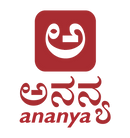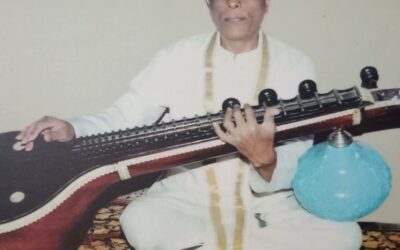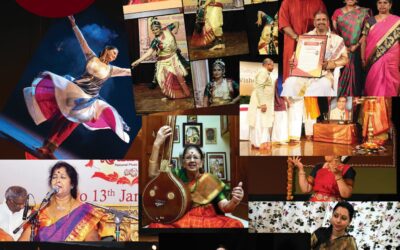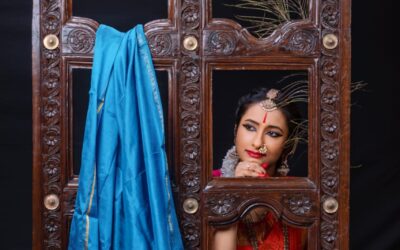Recipient of the Ananya Puraskara for 2022, Kalasinchana is honoured to interview Vani Ganapathy, performer, teacher and artiste par excellence. With a journey spanning several art-filled decades, Vani offers us a glimpse into the making of the artiste and the personality.
Tell us about your entry into the world of Bharatanatyam.
Coming from a lineage of artistic individuals, art thrived in the eco system in which I grew up in. My beginnings in dance were in Kolkata. My mother was learning and performing at the time and she would take me along when she went to class. I picked up from there and began to learn too. Under the watchful eyes of Guru TA Rajalakshmi, within 3 years I did my Arangetram by the time I was 7.
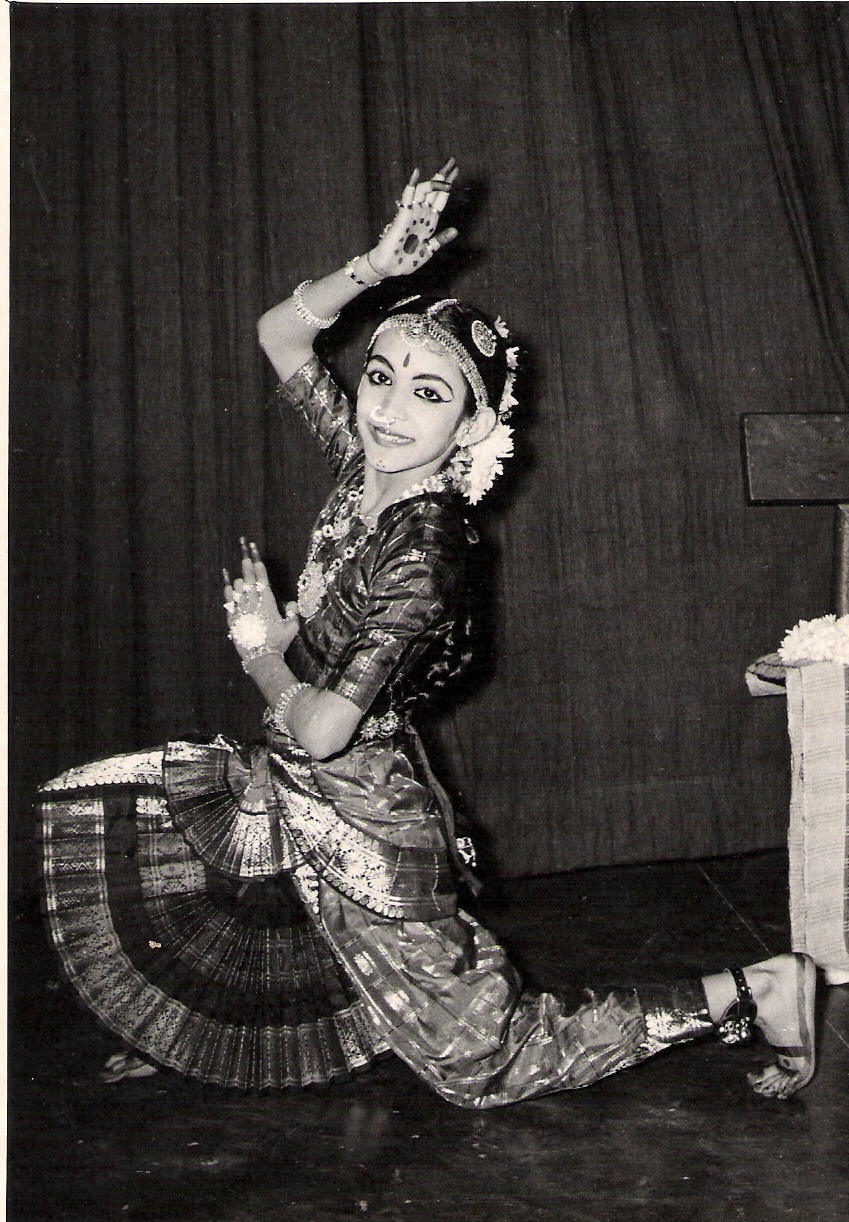
Vani’s 1st Performance, When she was 7 and the half.
My sister Meera joined too and we both debuted as a duo when she performed her Arangetram in 1962. Since then we performed as a duo for several years and were known popularly as Vani& Meera.
How did you come under the tutelage of Guru Kalyanasundaram Pillai?
My father was transferred to Mumbai (then Bombay) and my Guru Rajalakshmi Teacher said that her Guru’s family teaches in

Vani’s 2nd performance and Meera’s Arangetram with guru T A Rajalakshmi.
Mumbai and maybe I should pursue dance with them. Her Guru was Guru Kuppaiah Pillai who was PanchapakeshaNattuvanar’s direct descendant. We called him Kuppaiahthatha. I learnt with him too. Meera and I started classes with Mahalingam Pillai at RajarajeswariBharatanatyaKalamandir. Thrice a week my mother drove us from Andheri to Matunga for classes for several years.Our performances were conducted by both Mahalingam Master and Govindaraja Pillai.
We eventually moved to South Mumbai but my family ensured that our classes were never compromised on. My father would drive us or my grandfather would accompany us on the bus ride to classes. The entire family was encouraging of our dance and that was pivotal in our pursuit of it.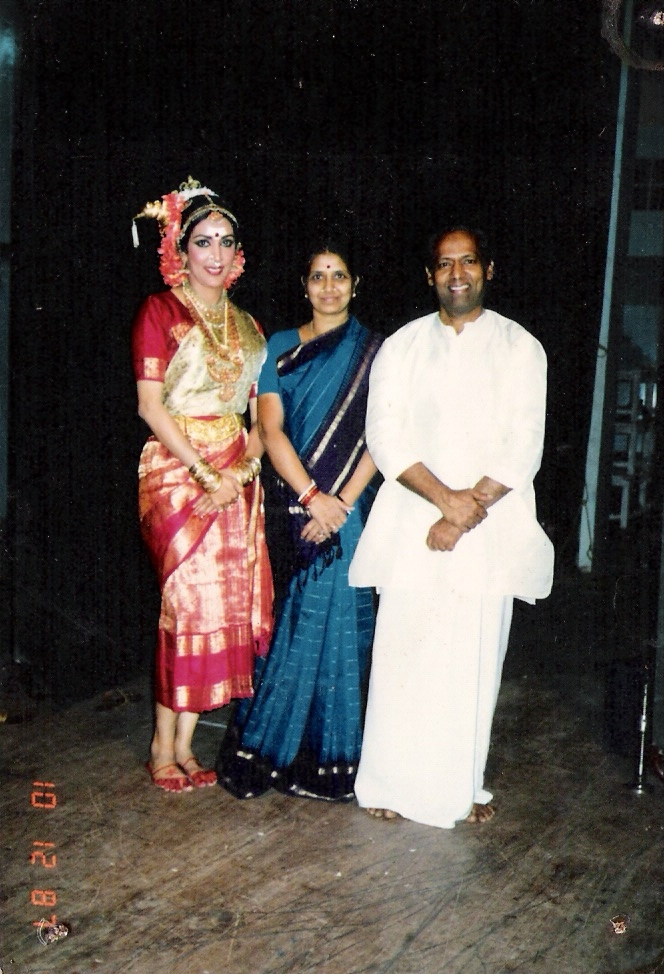
One day, Mahalingam Master suddenly told my parents that we shouldn’t have to travel such a long distance for classes and that his brother Kalyanasundaram Pillai was conducting classes at Bhulabhai Desai Institute. So that was how we came under the tutelage of Kalyanasundaram Master. But we started from ThattuAdavu all over again because there are subtle differences in technique between any two individuals even if they are brothers!
We were under his guidance then on. Masterji, as we called him, accompanied Meera and me and later on me in my solo performances on Nattuvangam and conducted the orchestra for several years. His impeccable sense of aesthetic and his knowledge and execution of rhythm, lyric and much more were all imbibed in the years that he taught us.
Your mother accompanied you as the vocalist in your performances. How would you describe this dynamic of having your mother accompany you?
My mother was a gifted singer and would accompany not just us in our performances but also all of Kalyanasundaram Master’s students. I do remember one instance of her not accompanying me though. Her throat had been infected and she could not sing so she requested P.Ramaa to sing for me and for the first time since I began performing at 7, she sat and watched the performance from the audience. “I can’t tell you how stress-free I was!” she exclaimed. For a mother to have her daughter up on stage and sing for her would have been a challenging task but she did it easily.
Just before she passed away, she gave me a list of musicians that she had watched and had enjoyed listening to and insisted that I set up a set of musicians for myself!
Vani and Meera were a popular performing duo. You eventually became a leading soloist. Tell us about those years of performance in duets and your transformation into a soloist.
As youngsters, Meera and I were invited to perform frequently at the Raj Bhavan in Mumbai for dignitaries. From the King and Queen of Nepal to premiers of other countries, we performed at the Raj Bhavan almost every other weekend. On one occasion MS Subbulakshmi was present at our recital and she said, “You girls should be in Chennai.”
We had come to Chennai for performances at many Sabhas but it was MS Amma’s comment that then urged us to perform at the Music Academy in an inaugural concert. Today, travel is easy with a flight taking you from one place to another, but when we were young, we would take the train from Mumbai to Chennai. But those long journeys and our performances are remembered fondly.


Till 1986, we danced as a duo, travelling widely. In 1986, PV Narasimha Rao, the then Finance Minister wanted a National Integration event and four Gurus, Birju Maharaj, Kelucharan Mohapatra, VempatiChinnasatyam and Kalyanasundaram Pillai, had been chosen to present their students in the event. Masterji asked that I perform a solo and that became my entry into the world of solo dancing.
This performance came at a juncture where I was also evaluating certain shifts in my life. I had also moved base to Bangalore. The larger context seemed to be conducive for pursuing the art form as a soloist. From then on, I devised performances as a soloist and Masterji and my mother would travel from Mumbai to Bangalore where I was living, to practice, rehearse and travel to performances.
The dynamic between teacher and student is one that keeps evolving. How do you see the dynamic having shifted from the days when you were a student to now when you teach?
As students of Masterji, we never questioned their method or choreography. I do not say this with any remorse, but in fact am just stating things as they were. Masterji was a stickler for clarity of lines, Angashuddham, Araimandi… If I received a correction on one instance, a second instance of correcting the same made me think that I had let him down. That was the reverence I had towards him. Also, Masterji belonged to a Parampara and he was truly a Guru in the real sense of the word. He and his wife were another set of parents to me while I was growing up. That dynamic is not easy to find in today’s context.
As a teacher myself, I do follow his technique of clarity and neat dancing but on the other hand, I encourage my students to ask questions and show me their own ideas in choreography. Many students of mine pursue multiple passions and I am happy to have the dance feed into their work outside this arena and vice versa. One of my students uses her knowledge of Kalari and Bharatanatyam to inform fitness training while another brings her academic expertise to the classroom.
The support system of the artiste can not be emphasised enough. Who or what formed your support system so that your dance grew from strength to strength?
Growing up, my entire family of parents and grandparents ensured that dance and art were integral to our lives. When I got married, it was my brother-in-law and sister-in-law who became almost another set of parents. My sister-in-law would sit for hours watching me rehearse, she would send me specially prepared soups on the day of the performance to endure the heat, they would be in the audience at every possible instance…
A year after my mother passed away, Mythili Mami (Kalyanasundaram Master’s wife) insisted that I perform for a temple festival near Sringeri, drawing me back into dance in a way that only people like Masterji and she would have been able to. They were almost another set of parents who cared and supported me in so many ways.
My staff of many years has also doubled up as backstage volunteer, even doing my hair for performances, travelling with me to all performances after my mother passed on. As artistes it is very important to ensure that your everyday living is not hassled so that art can be created in freedom. I have been blessed with the support of not just family or staff but also friends who constantly have my back.
As dancers, one also depends heavily on accompanists and I must say from the time of my mother and Masterji accompanying me to later times, I have been able to work with brilliant musicians.
Your aesthetic in costumes and stage décor is also much talked about. What aspects of life orliving feed into the development of this aesthetic?
Stage décor is a recent addition to Bharatanatyam performance. Back in the day, when one was invited to perform, it was only a blank stage or the preferred decor of the organisation that you danced with. I would of course request organisations to not put up banners on the backdrop because from the audience’s perspective, it distracts from the dance.
Over the years, I have been able to create stage decors for my productions. From simple décor to audio-visual screens, each production necessitates a certain aesthetic. Some are discussed at length with collaborators while some occur to me as the production takes shape.
In ‘Panchakanya’, the Devi adorned the same colour as your costume colours, that changed for each of the Kanyas.
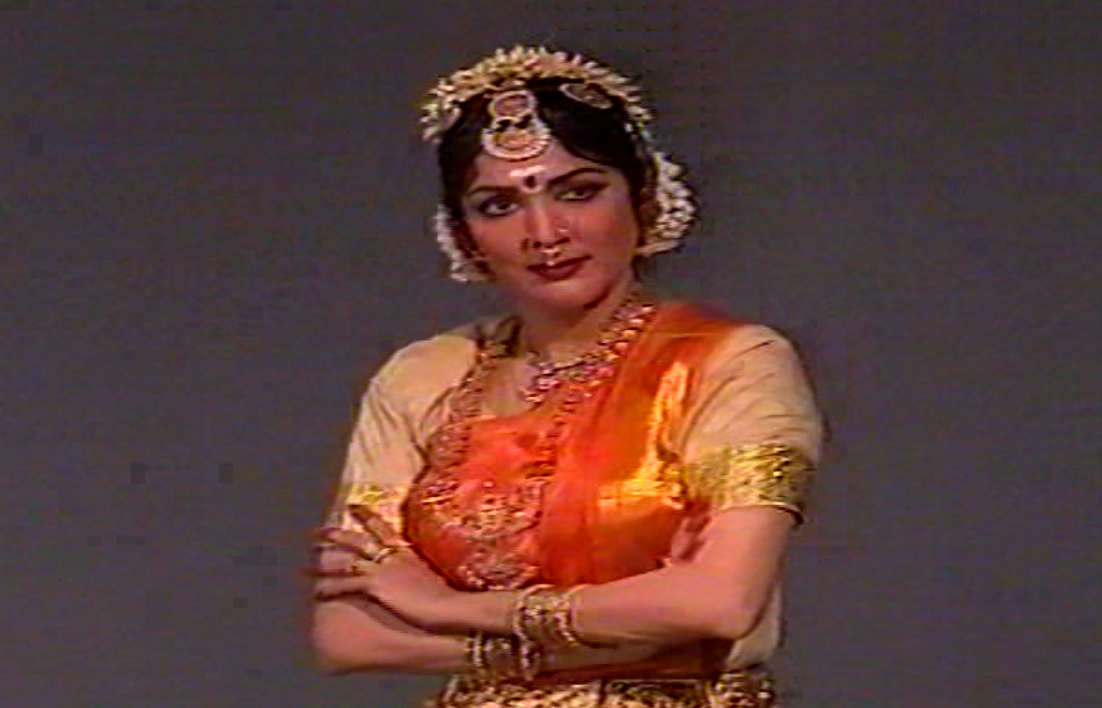

The front fan and the Daavini of the Bharatanatyam costume was decided by colour for each of the Kanyas. In those days, the front fan of the Bharatanatyam costume was always stitched with buttons and hooks. It took a few minutes to change the fan between segments but I wanted to ensure that the connecting audio visuals were not marred by long gaps. I requested Aiyelu who did all my costumes to make a costume with the Velcro so that it would be time-efficient to change the fan and the production would be seamless. So the Velcro in the front fan that most artistes use today was born at the time of ‘Panchakanya’!
Another unique aspect of Panchakanya was that since there were 5 women being venerated, the PanchaNadai was used to denote each of the Kanyas. It also was in the period where I began to discuss ideas and aspects of the production with Masterji. He would then create passages and sequences, pick verses and even write a few. My mother in consultation with him would create the music of the productions. Panchakanya itself had 91 songs that were woven together. Masterji had composed a Kautuvam on the Panchakanya.
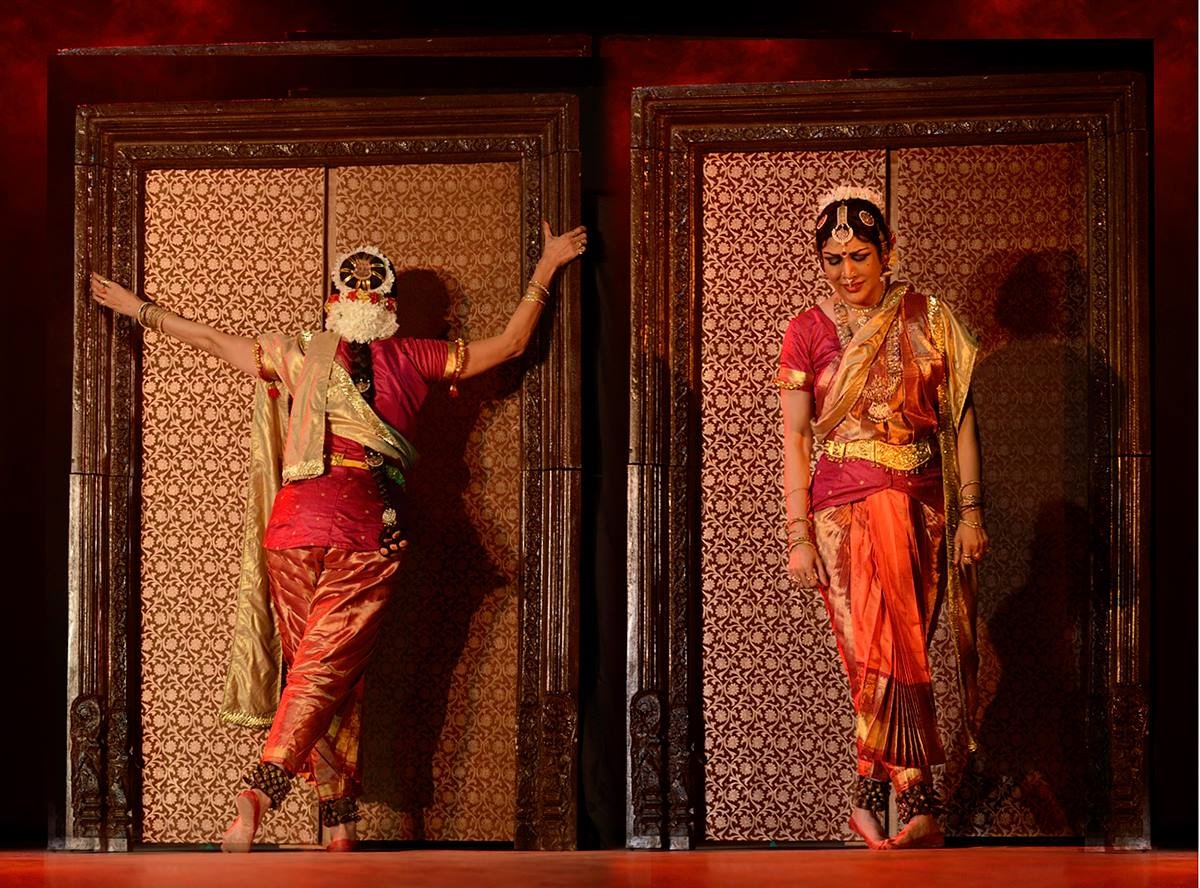 Many years later, I used the sollukattu of the Kautuvam with different lyrics in ‘Dwaram’!
Many years later, I used the sollukattu of the Kautuvam with different lyrics in ‘Dwaram’!
The dance scene has evolved with time. How do you view the evolution over the past decades?
From a time of doing 13 items for two to two and a half hours to a houseful of undistracted audience to the current times when such audiences are rare to come by, things have changed. In terms of being in the audience, I have enjoyed watching dance then and I continue to enjoy watching the varied formats that it has taken on now. I have recently seen very interesting ideas being brought out in Margams and thematic performances.
In the digital era, livestream has occupied a certain prime place in the dance scene as well. Livestreaming a dance performance may come close to watching a live performance but the immediate response of the audience and the rapport that one builds with the audience in a live performance stand sacrificed to emojis and comments.
Masterji’s jathis were full of complex patterns, fast, two to three minutes long jathis were commonplace, there was no space to feel tired or skip certain demanding adavus. Today, however I prefer to adjudge each child’s potential and allow them to chew only as much as they can. However, I must say that without the aid of recording devices, our memory of what we learnt was much stronger and continues to be compared to my young students who will video record the choreography and depend on it more than their own memory.
When one says ‘Art for Arts Sake” what does that mean to you?
I do not believe in quotes. I do believe that art should be from the heart. I never trained to be a teacher. I never thought that my livelihood would come from being a teacher. I never have approached an organiser for a performance and yet performances have constantly come my way. Beautiful collaborations have taken shape over the years. Until the pandemic hit us, it never occurred to me that plans can go astray. As a disciplined person myself, I ensured I reached a day ahead of a performance if it was outside Bangalore, planned rehearsals and performance days to the best of my knowledge. I believed that everything would pan out. The pandemic has created a different kind of anxiety because so much isn’t in our hands. There is also war happening in another part of the world. Amidst all this, it becomes all the more important to realise that art has to be from the heart.
For my students too, by their own admission, dance is a path to take for all reasons and in all seasons. Art or culture needs to be understood for the depth that it offers in our lives, be it dance, music, fine art, theatre or even festivities.
